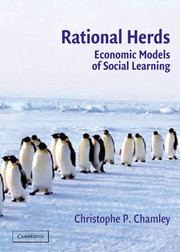11 - Guessing to Coordinate
Published online by Cambridge University Press: 12 January 2010
Summary
Shall we dance?
Actions bear externalities, which may generate strategic substitutability (e.g., entering a new competitive market) or strategic complementarity (e.g., speculating against a currency with a fixed exchange rate). Each agent has to choose his strategy and guess what others do at the same time.
Under some conditions, some strategies are strictly dominated and thus ruled out. The iterated elimination of dominated strategies may converge to a unique strategy that defines a strongly rational expectations equilibrium (SREE). When the process is applied under strategic substitutabilities, it strengthens the Nash equilibrium. When there are strategic complementarities and multiple Nash equilibria under perfect information, the game is extended to include imperfect information, and there may be a unique equilibrium in the extended game. Applications to speculative attacks against a fixed exchange rate are discussed.
In the previous chapters, actions generate an externality because they convey valuable information about a state of nature that affects the actions and the payoff of each agent. In this and the following two chapters, actions generate externalities per se. An externality may affect the level of payoff, and this may be important for social welfare, but such an effect is not the issue here. Our focus is on the incentive of agents to act together or not. This incentive depends on the marginal payoff of the activity or the differential payoffs between discrete choices. Theory considers any type of externalities, but in practice, most of them fall in two broad categories: the incentive of an agent to act is either dampened or stimulated by the average level of activity of other agents.
- Type
- Chapter
- Information
- Rational HerdsEconomic Models of Social Learning, pp. 237 - 267Publisher: Cambridge University PressPrint publication year: 2003



